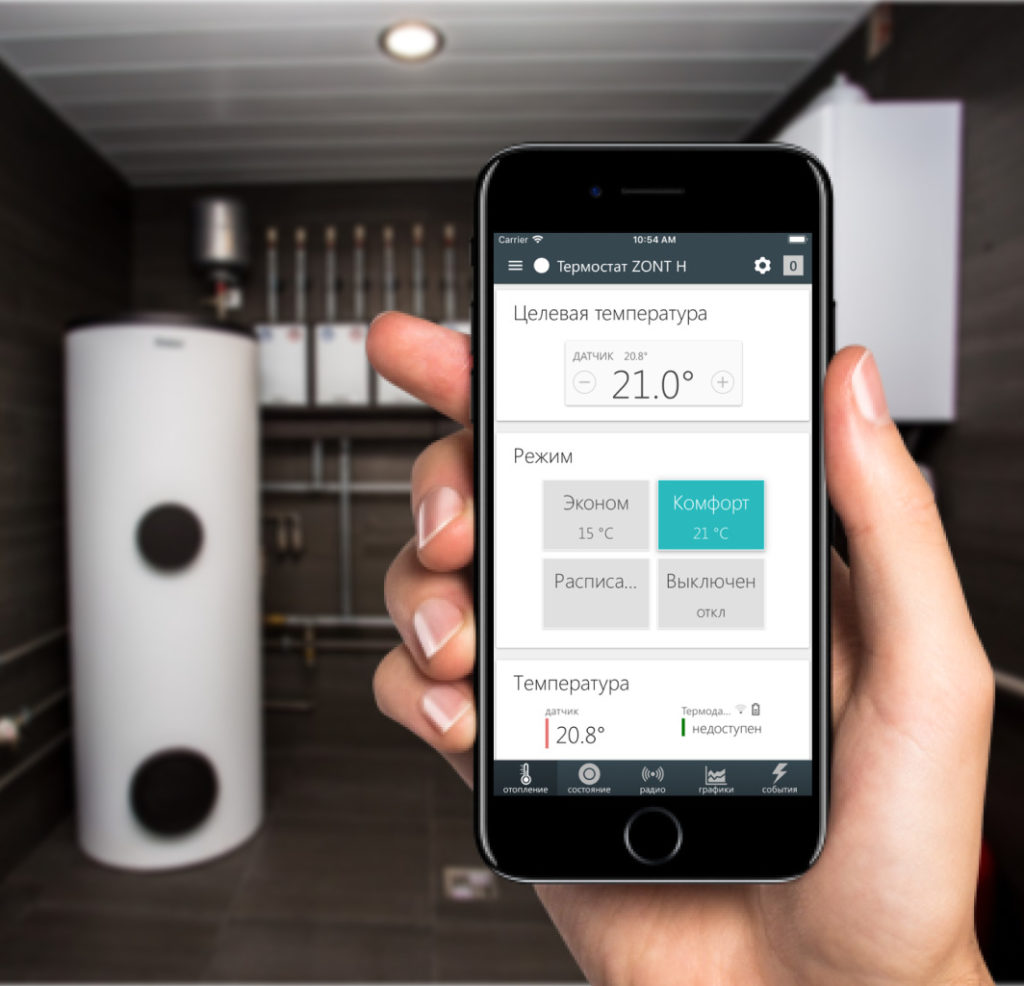Heating automation - what are the modern and affordable options?
When automation for heating systems is mentioned, everyone understands this concept differently. Therefore, we decided to bring the principles of automation of heating and hot water systems under a certain common denominator. Responsibly, we can say that automation for the heating system is needed and can be installed only for engineering purposes. In other words, the user of the boiler may not even suspect that he has an automatic heating system. Custom functions are traditionally associated with climate control in the heating system. But this system can work just fine without direct heating automation.
Diagram with a four-way valve that controls the central heating circuit1: 1 - boiler, 2 - burner, 3 - controller, 4 - boiler temperature sensor, 5 - flue gas temperature sensor (for information only), 6 - four-way valve actuator, 7 - mixer circuit pump, 8 - mixer circuit temperature sensor, 9 - hot water boiler, 10 - hot water pump, 11 - hot water supply sensor, 12 - weather temperature sensor, 13 - room panel or standard room thermostat, 14 - return temperature sensor (optional for system operation).
We reveal the concept of heating automation in detail
We have already considered these questions in our publications and gave examples. strapping, reinforcement groups, thanks to which it is possible to realize thermoregulation in rooms. These processes can all be automated, but in the simplest case they can be manually configured. At the same time, automation for heating systems is important and practically mandatory, since it allows you to ensure the physical parameters of the use of hot water and the supply of coolant to the heating circuit.
Let's consider this issue on the example of using a four-way valve in a system with a solid fuel boiler. This type of valve, both two- and three-way, is controlled by a microcontroller and belongs to heating automation fittings. Only its main function in the proposed case is to ensure the safe operation of the boiler. Moreover, it is safe not only for the user, but also for the boiler generator itself.
Boiler circuit automation to ensure correct operating conditions
We considered the issue of options for piping the boiler circuit in a publication about inexpensive fittings for heating systems. For the reader who is just getting acquainted with heating systems, we note. That the heating systems have a boiler and a heating circuit. The highlighted issues can affect both pipelines for the movement of the coolant, but more specifically concern the boiler circuit. This is a closed heating circuit, where boiler generators and heat sources are connected.
If using pre-adjustable valves and balancing valves allows you to adjust the parameters of the circuit in an analogous way, then two-, three- and four-way valves are designed to automate the operation of heating and boiler circuits. The process is automated using an external or built-in programmer in the boiler generator or a heating microcontroller. If solid fuel boilers FOCUS have a built-in microcontroller, but your boiler does not have it, it's okay, the programmer can be external.
Multi-way valves at a glance
We list the main functionality of valves for heating automation:
- the two-way valve has one inlet and one outlet, it is used as a control or shut-off valve or a check valve, blocking the flow of the coolant. It works on the principle of raising a ball-regulating sleeve, which changes the flow rate through the valve. It is also used to automatically equalize the temperature on the radiators and change the heating level.
- the three-way valve has two inlets and one outlet. Most often it is used as a mixing valve for mixing cold or hot water in hot water supply and heating systems under the control of a microcontroller.
For example, it is used for support of temperature indicators of hot water supply, supplying water of the same temperature to the boiler inlet or to the system, controlling the boiler overheating and to lower the temperature when supplying it to the low-temperature circuit of the underfloor heating;
- the four-way valve has two inputs and two outputs, it is often used to separate the heat flows of hot water supply and heating with a decrease or increase in temperature. The functionality of four-way valves is very diverse and depends on the specific model.
In heating systems with a solid fuel boiler, four-way valves are mainly used to maintain the temperature of the inlet pipe. They are an alternative to the thermo-mixing 3-way valve. Otherwise, with large drops, condensation is observed. The heat exchanger circuit of the boiler is highly corroded if it is made of steel. Cast iron contours are cracked. The same effect is typical for welded parts, cracks appear at the welding site. The automation for the heating system allows them to be avoided.
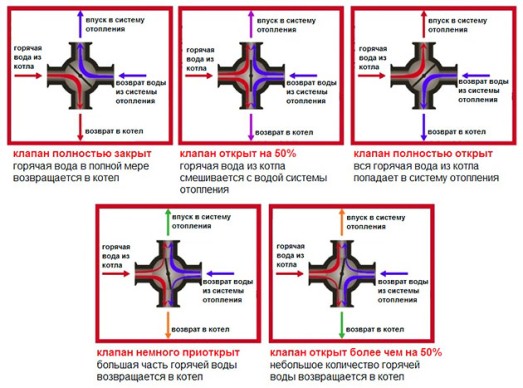

In other words, the installation of an armature group that maintains the temperature of the coolant inlet to the boiler ensures a long service life of the boiler generator. And the automation of this process is mandatory, but rarely performed by the wizards.
A practical example of the use of a four-way valve in a heating and hot water supply system
The four-way valve is used to separate the heating agent supply to the DHW boiler and the heating circuit. Moreover, the heating circuit has a priority, and the supply of the coolant to the DHW boiler is year-round; in some cases, hot water treatment is done from a solid fuel boiler year-round. For example, in the case pellet boilers FOCUS.
When installing a four-way valve, mixing parameters can be controlled. For example, in the middle position of the valve 50%, the coolant moves towards the heating system. At the same time, a mixture of the coolant "from the return" is provided to ensure the temperature on demand. Even if there is no climate control, then monitoring of temperature indicators is necessary for all types of radiators except cast iron, in order to ensure the temperature of the supplied coolant is not higher than 90 degrees Celsius.
The four-way valve allows you to regulate the flow of the coolant in terms of temperature in a fairly wide range of values, due to the change in the flow of the coolant in proportions. For example, 20% goes into the heat circuit in the off-season, and 70% goes into the hot water supply. Summer mode assumes only DHW supply to the boiler.
We offer you two classic thermal schemes for deployment in your boiler rooms. One with a DHW boiler supplied with heating medium in summer and winter mode. The second provides the heating circuit with a heat carrier of a certain temperature. Obviously, there can be many solutions if the control unit allows it.
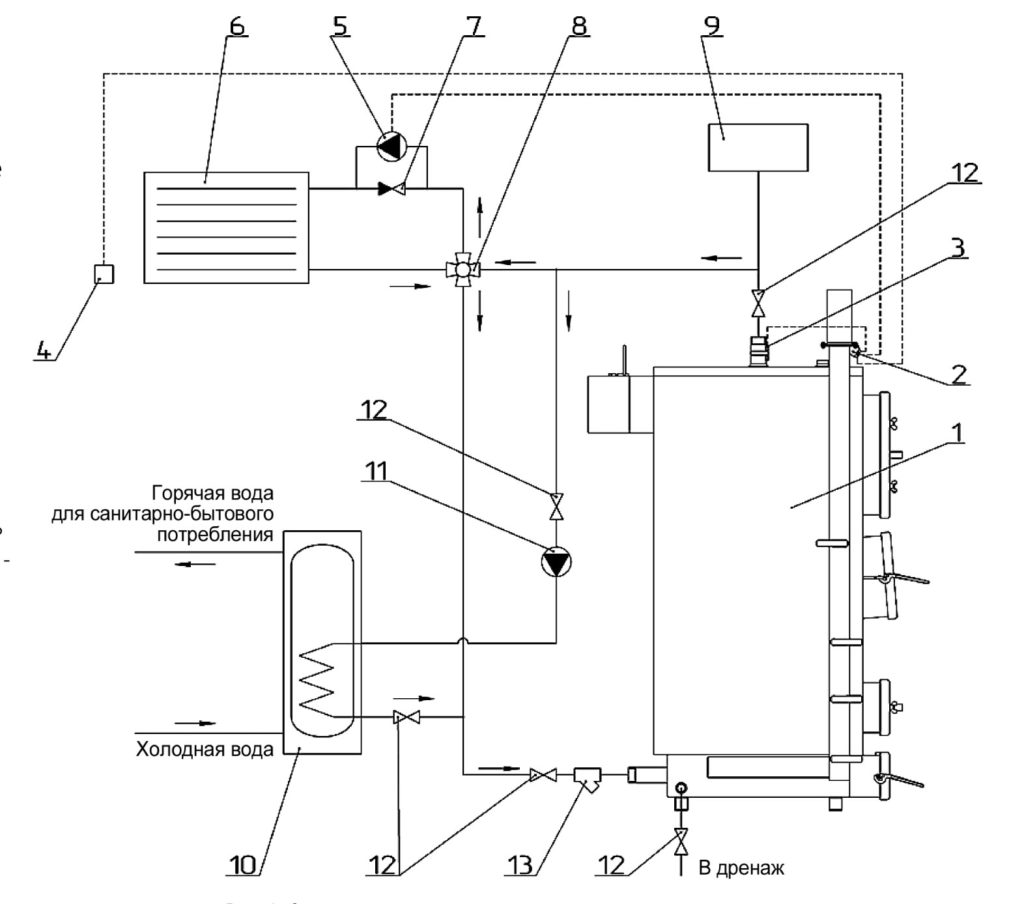

Legend:
1 - boiler; 2 - boiler control automation unit; 3 - coolant temperature sensor; 4 - room thermostat; 5 - circulation pump; 6 - heat consumer; 7 - differential valve; 8 - four-way mixing valve; 9 - expansion tank; 10 - hot water boiler; 11 - boiler pump; 12 - shutoff valves; 13 - filter.
Features of the use of valves in heating systems
The four-way valve can ensure not only the operation of the hot water supply, the boiler, but also the constancy of the flow. This allows you to control the parameters of the boiler. For example, using an automatic draft regulator, which switches the combustion to a less intense mode, maintaining the temperature due to pyrolysis gases.
In fact, with certain skills, it is possible to automate the work of not only the boiler circuit, but even the furnace by controlling the blowing and draft. But the simplest, and at the same time, a very important option for heating automation implies maintaining optimal conditions for pumping the coolant in the heating circuit and providing hot water supply, if any. Automation for the heating system is presented widely and varied in models to satisfy most of the wishes of users.
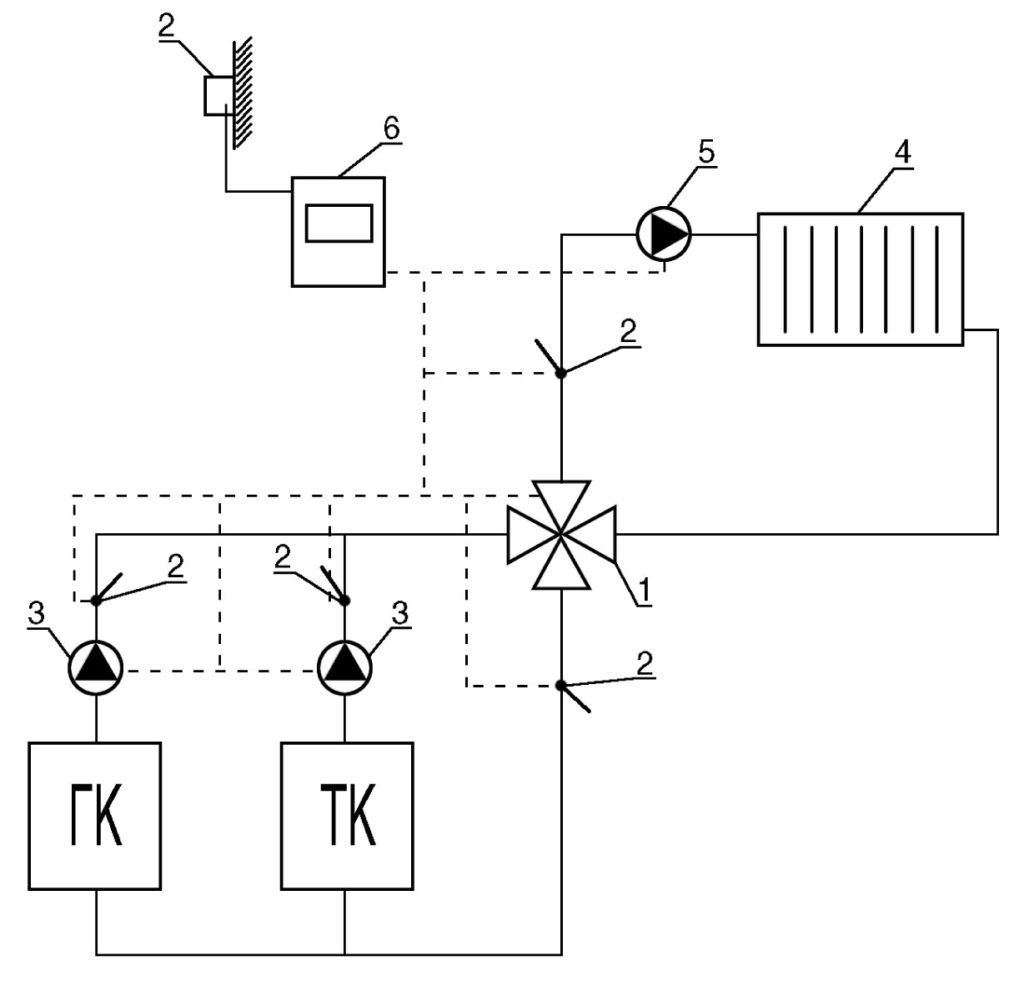

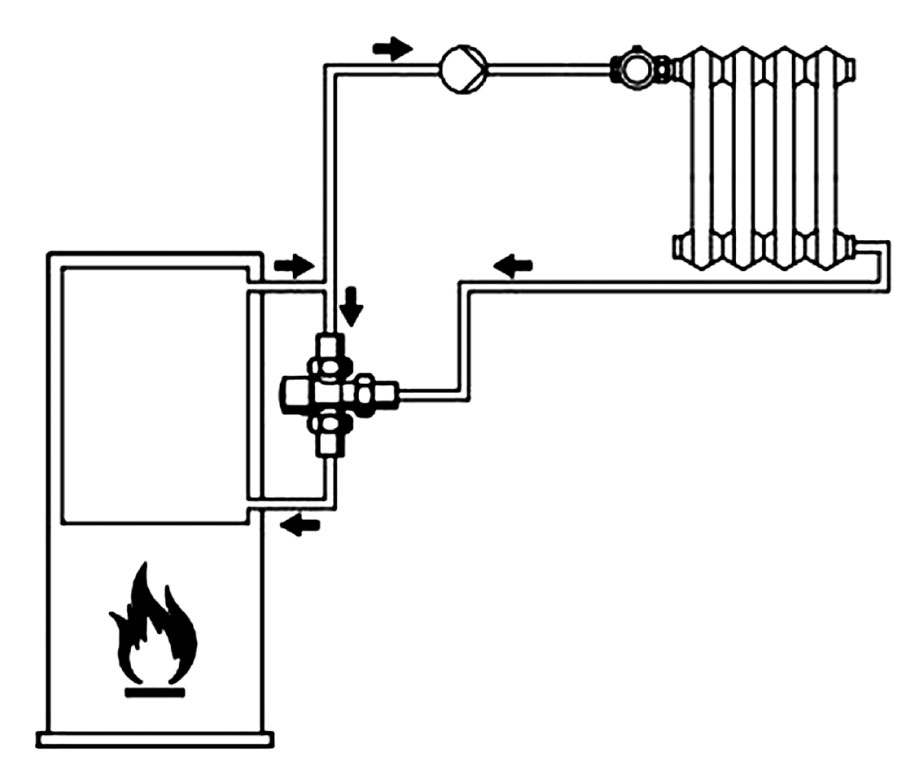

Legend:
TC - solid fuel boiler; GK - gas boiler; 1 - four-way valve; 2 - temperature sensor; 3 - boiler pumps; 4 - heat consumer; 5 - circulation pump; 6 - controller
Four-way valves provide synchronous operation of the control system with temperature sensors, as well as the operation of several control generators in the system. In combination with the control system, they ensure the operation of the heating system in summer and winter mode, help to turn on and off the heating system depending on the temperature indicators of the room.
Their functions include ensuring the uninterrupted operation of heating and consumable units that have not previously been combined. Now this is solved only by a set of valves and connecting the control system to the heating system. The automation for the heating system is very diverse and available for every user.
Buy automatic pellet boiler FOCUS
- a heating system project for a private house with one circuit on a solid fuel boiler with a heat accumulator;
- design of a heating system with one circuit on a gas-fired boiler and a FOCUS pellet burner with analogue climate control.

